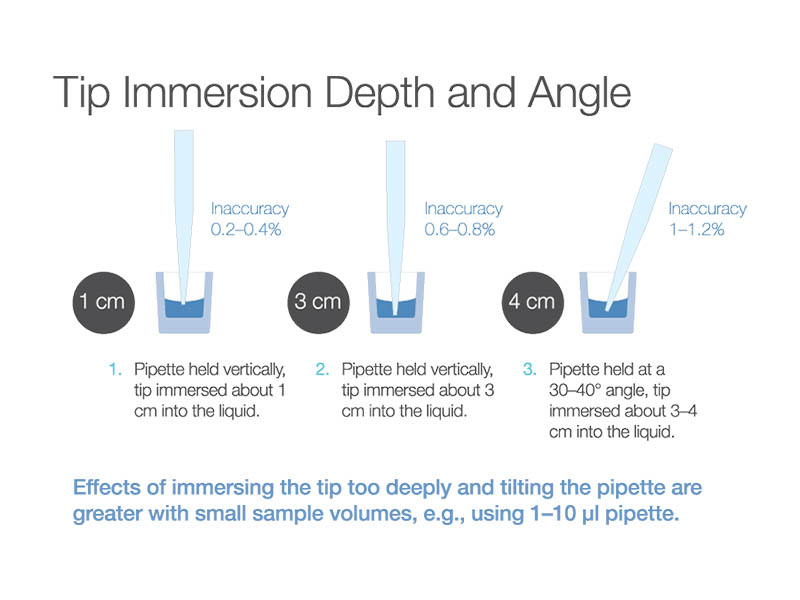With the increasing demand for accuracy and precision in the laboratory, the importance of understanding and developing the best pipetting technology is also increasing. Here are some suggestions that can improve the accuracy of pipetting. Step by step, understand how much you have mastered, and take it as part of your daily pipetting process, which can take your pipetting technology to a new level.
1. Pre-wet the Pipette Tip
Pump and drain any sample liquid at least three times, and then pump the sample for transportation. Evaporation in the tip will cause a large amount of sample loss before transportation. Prewetting increases the humidity in the tip, thereby reducing any chances of sample evaporation. Using the same sucker to deliver multiple samples without pre-wetting will result in a smaller volume of the first few samples. When volatile samples (i.e. organic solvents) are used, the need for prewetting increases.
2. Immerse the Tip in the Proper Depth During the Suction
Before suction, fully immerse the needle tip below the meniscus. Large volume pipettes (1-5 ml) should be immersed in 5-6 mm, while small volume pipettes should be immersed in 2-3 mm. Too little immersion (especially when using a large capacity pipette) can cause air to be drawn in. Too much immersion will cause the sample to stick to the outside of the tip. Touching the bottom of the container with the tip may limit suction.
3.Continuous Pause After Aspiration
After taking the sample, leave the tip in the liquid for about one second. After the plunger stops, the liquid in the tip takes a little time to complete the movement, so if not, it will lead to too small volume. Make these pauses as consistent as possible.
4. Use Consistent Plunger Pressure and Speed
Press and release the plunger smoothly. Try to apply the same pressure and speed when taking and distributing each sample. Repeatable actions produce repeatable results.

5. Pull the Pipette Vertically
Always hold the pipette vertically and avoid touching the side of the container when pumping the sample. After sampling, pull the pipette directly out of the center of the container. Small volume (< 50 µ 50) This technology is particularly important in the future. When the pipette is removed from the sample, holding the pipette at a certain angle will change the suction volume. Contact with the side of the container may result in wicking and volume loss due to surface tension.
6. Check the Tip Before Distributing the Sample
Before dispensing, carefully remove the droplets on the outside of the tip with a lint-free cloth to ensure that they are far away from the opening of the needle tip. If the sample is contacted at the opening, the absorbent material will quickly absorb the sample from the tip. Unnecessary wiping off the tip will increase the possibility of sample loss, so please use it with caution.
7. Examine the Tip After Sample Distribution
When distributing the sample, place the tip on the side of the contact container to deliver any remaining sample in the tip. Press your thumb on the second stop of the plunger and remove the tip to avoid the sample from breathing the tip of the suction tube again. Make sure you see the sample leave the tip.
8. Use Standard Mode Pipetting
For all water-containing samples, choose standard (or forward) mode instead of reverse mode, but for particularly viscous or volatile samples, you may consider using this mode. If reverse mode is used for a normal water sample, the delivery volume of the pipette often exceeds the calibrated volume. On the other hand, the use of standard models for viscous or volatile samples may lead to insufficient delivery.
9.Working at Ambient Temperature Balance
Allow the liquid and equipment to reach equilibrium at ambient temperature before starting pipetting. The volume of sample transported by air displacement pipette varies with air pressure, relative humidity, and vapor pressure of the liquid, all of which are related to temperature. Working at a single and constant temperature can minimize this change and improve the overall accuracy.
10.Minimize Pipette Operation
Release the pipette, return it to the pipette holder, or lower it without pipetting. Always wear gloves to reduce body heat transfer to the pipette and avoid handling the tip of the pipette or sample containers that have not been pipetted. The transfer of body heat during transportation disturbs the temperature balance, which may lead to changes in transport volume.
Nanjing Superfit